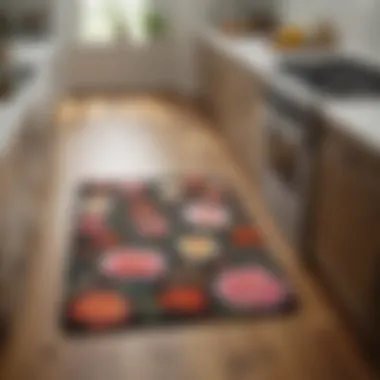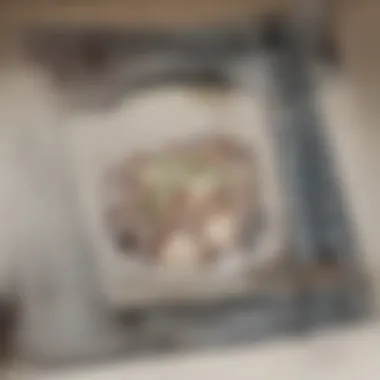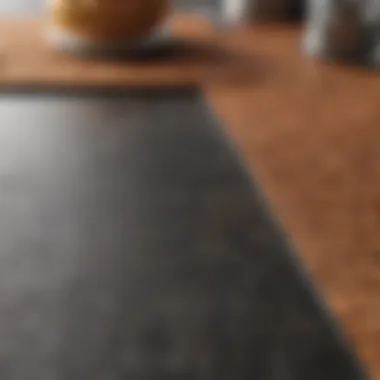Enhance Your Kitchen with Decorative Cushioned Mats


Intro
Decorative cushioned kitchen mats have gained popularity in recent years. This trend is due to their ability to provide both aesthetic and practical benefits. These mats serve essential functions while also enhancing the visual appeal of a kitchen. Understanding their various features, designs, and uses is vital for any kitchen enthusiast.
These mats come in different styles and materials, making it easier for individuals to find options that suit their personal taste. Not only do they add a touch of elegance to cooking spaces, but they also promote comfort during prolonged periods of standing.
As we navigate through the essential aspects of decorative cushioned kitchen mats, readers should expect to learn about their functionality, maintenance, and the best market options available today. By the end of this article, kitchen lovers will be equipped with insightful information to make well-informed choices that cater to their culinary spaces.
Foreword to Decorative Cushioned Kitchen Mats
Decorative cushioned kitchen mats serve a dual purpose, merging functional elements with aesthetic appeal. In culinary spaces where comfort is essential, these mats play an important role. They not only provide a soft surface for standing but also enhance the overall decor of the kitchen. Understanding their benefits is crucial for anyone looking to improve their cooking environment.
Definition and Purpose
Cushioned kitchen mats are specially designed to offer support and comfort while standing for prolonged periods. Typically made from materials that absorb impact, they help alleviate stress on the feet and joints. The primary purpose is to reduce fatigue during activities such as cooking or doing dishes.
In addition to comfort, decorative features cannot be overlooked. Many of these mats come in various colors and patterns, allowing them to blend seamlessly into different kitchen themes. This feature makes them not just practical, but also a valuable design component that adds a touch of style to the culinary space. The integration of functionality and visual aesthetics is what distinguishes these mats in the world of kitchen accessories.
Historical Evolution
The concept of kitchen mats is not entirely new. Historically, mats found in kitchens were typically utilitarian, aimed solely at providing a barrier against cold flooring. However, with evolving home design trends and increased awareness of ergonomic health, the focus has shifted.
From simple rubber or fabric mats, there emerged a vast array of designs and technologies. The advent of anti-fatigue mats marked a significant evolution, providing not just comfort but also enhanced foot support and improved posture. Many mats now leverage advanced materials that provide better durability and design flexibility, reflecting changing tastes and preferences.
The transition from purely functional to decorative mats mirrors broader trends in home interiors, where comfort and aesthetics are equally valued. Now, kitchen mats are seen as essential elements in modern interior design, balancing both form and function.
Functional Benefits of Cushioned Kitchen Mats
Cushioned kitchen mats serve numerous purposes that extend beyond mere aesthetics. Their functional benefits significantly enhance the kitchen experience. These mats improve comfort, stability, and safety, making them essential in any culinary setting. Understanding these advantages helps consumers make informed choices when selecting mats that best fit their needs.
Ergonomic Advantages
Cushioned kitchen mats are specifically designed to address the discomfort associated with prolonged standing. When cooking or doing dishes, many people find that standing for extended periods can lead to fatigue and stress on the feet and joints. The ergonomic design of these mats provides a soft surface, helping to distribute body weight more evenly. This balance reduces strain on the feet, legs, and back.
Research shows that anti-fatigue mats can decrease discomfort by up to 50%. This significant reduction encourages users to spend more time in the kitchen without experiencing discomfort.
Slip Resistance
The kitchen environment can often be slippery, especially when water spills or cooking residues are present. Cushioned mats often come with textured surfaces that reduce the chances of slipping. This feature not only helps maintain stability while moving around the kitchen but also minimizes the risk of accidents.
A mat that provides slip resistance becomes an essential safety tool, especially in homes with children or elderly individuals. Thus, the right mat can enhance an overall safe cooking or cleaning environment, ensuring that users can move with confidence.
Impact Absorption
Every time a foot strikes the ground, there is an impact force transmitted through the body. Cushioned kitchen mats absorb this impact, reducing the stress placed on joints.
Whether you're chopping vegetables or washing dishes, standing on a cushioned surface can heavily decrease the wear and tear on your body. This beneficial feature improves overall health and well-being over time.
Many users report feeling less soreness and fatigue at the end of the day, directly correlating their comfort with the choice of mat.
"Cushioned mats can significantly enhance your kitchen experience, balancing both comfort and safety."
Aesthetic Considerations in Home Design
Aesthetic considerations in home design play a crucial role in creating spaces that are not only functional but also appealing to the eye. Decorative cushioned kitchen mats are an often-overlooked element that contribute significantly to the overall aesthetic of a kitchen. They serve as more than just a practical accessory; they can enhance the décor, introduce color, and bring texture into the kitchen environment.
One of the main benefits of incorporating these mats is their ability to harmonize with various design styles. Whether your kitchen leans towards a modern, rustic, or traditional design, there are decorative cushioned mats available to complement these themes. It is pivotal to understand how to select the right mat that aligns with your kitchen’s character, considering aspects like shape, size, pattern, and color.


Design Trends
In recent years, design trends have shifted towards personal expression and individuality in home decor. This trend is reflected in kitchen mats. Current popular styles include geometric patterns, florals, and vintage designs. These motifs allow homeowners to inject their personality into their culinary spaces, making the kitchen welcoming. The integration of bold colors and stylish patterns can create a focal point in a kitchen, thereby influencing the overall mood of the area.
Moreover, multifunctionality has gained traction. Consumers now prefer mats that not only look good but also serve ergonomic benefits, making them a dual-purpose addition in today's kitchens.
Color Coordination Techniques
Color plays an essential role in interior design and can significantly impact the feel of a kitchen. When selecting decorative cushioned mats, color coordination should be a top priority. One effective technique is to identify the dominant color palette already present in the kitchen and choose a mat that either complements or contrasts these hues.
For instance, if the kitchen features shades of gray and white, a vibrant mat in teal or mustard can introduce dynamism and visual interest. Conversely, selecting a mat that ties in with existing cabinetry or wall colors can create a sense of cohesion across the kitchen space. It’s also beneficial to consider seasonal changes; warmer colors can be used in colder months for a cozier feel, while cooler tones can promote a refreshing atmosphere during the summer.
Material Selection
When it comes to selecting materials for decorative cushioned kitchen mats, durability and aesthetics should not be mutually exclusive. Various materials, such as rubber, foam, and even textile blends, can provide the comfort one seeks while enhancing the style of the kitchen. Rubber mats, for example, provide superior grip and are easy to clean, making them a practical choice. On the other hand, textile options can introduce softness and warmth, bringing an entirely different feel to the space.
It is wise to consider the maintenance requirements of different materials. Some fabrics may hold onto dirt and require more frequent cleaning, while others may only need a simple wipe down. Therefore, understanding how different materials react to kitchen conditions—moisture, spills, and foot traffic—will guide consumers in making informed decisions.
"A well-chosen kitchen mat can uplift the look of your culinary space while providing comfort underfoot."
Health Implications of Kitchen Mats
The role of kitchen mats extends beyond mere aesthetics and practicality; they serve a significant purpose in promoting health and well-being. While many consider flooring solutions in a kitchen solely for their visual appeal or durability, the implications on health are equally crucial. Decorative cushioned kitchen mats are designed not only to enhance decor but also to provide support and comfort, addressing common issues faced by those who spend extended periods standing in the kitchen. These mats reduce fatigue and improve posture, which are vital elements for anyone who enjoys cooking or working in the culinary space.
Reducing Fatigue
Standing for long durations can lead to leg fatigue, back pain, and discomfort. Cushioned kitchen mats provide a soft surface that absorbs some of the pressure exerted on joints and muscles. The material in these mats allows for slight movement, which helps stimulate blood circulation. As your feet shift on the mat's surface, it combats stiffness and tiredness.
Some key benefits of reducing fatigue with cushioned kitchen mats include:
- Enhanced Comfort: By standing on a cushioned surface, the discomfort often associated with hard flooring diminishes.
- Increased Productivity: Less fatigue translates to a more enjoyable cooking experience, allowing you to engage more fully in culinary tasks.
- Recognition of Personal Limits: A soft surface can serve as a reminder to take breaks and not push through pain, fostering a healthier approach to kitchen work.
Support for Posture
Correct posture can be overlooked when engaging in prolonged standing tasks. Cushioned kitchen mats play a critical role in maintaining healthy posture alignment. When standing without proper support, the likelihood of slouching or shifting weight unevenly increases, which can lead to muscle strain and discomfort.
Benefits of proper posture support with these mats are as follows:
- Alignment of Spine: Cushioned mats encourage good standing posture, which promotes alignment of the spine, potentially reducing chronic pain.
- Weight Distribution: These mats help to evenly distribute body weight across the feet, supporting hip, pelvic, and spinal alignment.
- Reduced Risk of Injury: Improved posture reduces the chance of injury resulting from poor form, such as strains or sprains that may occur over time.
"A good mat is not just a cushion; it is an investment in your health while cooking."
Maintenance of Cushioned Kitchen Mats
Maintaining decorative cushioned kitchen mats is essential to prolong their life and appearance. A kitchen mat can quickly become the center of activity, and neglect can lead to wear, discoloration, and unpleasant odors. Proper maintenance not only enhances durability but also ensures that the aesthetic appeal remains intact. This section will delve into cleaning recommendations and longevity factors, providing a comprehensive approach to caring for these important kitchen accessories.
Cleaning Recommendations
Regular cleaning of cushioned kitchen mats is vital. Most mats are made from materials that can gather dirt, grease, and stains over time.
- General Cleaning: Wipe down the mat with a damp cloth to remove any surface debris. This should be done frequently to avoid buildup.
- Deep Cleaning: Depending on the fabric, a machine wash may be suitable. Check the manufacturer’s labels for specific instructions. If machine washing is not feasible, a gentle mix of warm water and mild detergent can work wonders. Use a soft-bristle brush to scrub any stubborn stains, ensuring not to damage the surface.
- Drying: Allow the mats to air dry completely after washing. Avoid exposure to direct sunlight for prolonged periods, as this can cause fading.


"Regular care not only keeps your kitchen mats looking good but also ensures you have a hygienic space to cook and gather."
Longevity Factors
To maximize the lifespan of cushioned kitchen mats, several factors deserve consideration:
- Material Quality: High-quality materials are designed to withstand wear and tear. Utilizing mats made from materials like polyurethane or rubber can provide better durability.
- Foot Traffic: The level of foot traffic affects the mat's condition. For areas with heavy use, more durable options should be considered.
- Environment: The kitchen environment plays a role in longevity. Mats exposed to excessive moisture or high temperatures may degrade quicker. Placing mats away from direct heat sources is advisable.
- Proper Usage: Avoid dragging heavy items across the mat. This not only harms the mat surface but can also lead to tears and punctures.
- Storage: When not in use, consider rolling or folding mats instead of stacking them. This helps prevent creasing and damage due to pressure.
By following these maintenance tips, kitchen mats can remain functional and stylish for many years.
Types of Decorative Cushioned Kitchen Mats
Cushioned kitchen mats serve both functional and aesthetic purposes in the culinary space. Understanding the various types available is essential for selecting mats that fit your specific needs, enhancing comfort and overall kitchen design. The following sections break down the primary categories of decorative cushioned kitchen mats, illustrating their unique features and benefits.
Anti-Fatigue Mats
Anti-fatigue mats are specifically designed to alleviate discomfort caused by long periods of standing. These mats utilize advanced materials that support body weight and promote better posture. The ergonomic design helps reduce strain on the back and legs, which can be particularly beneficial in a busy kitchen environment where cooking and cleaning can take hours.
- Key Features:
- Benefits:
- Made from foam or gel, providing cushioning.
- Often features textured surfaces for better grip.
- Available in various sizes to fit different kitchen spaces.
- Reduces fatigue and discomfort from standing.
- Encourages more active standing postures.
- Enhances productivity by allowing longer periods of activity without discomfort.
Beautifying Options
In addition to comfort, cosmetic appeal is sometimes a priority. Beautifying options for kitchen mats come in various styles, patterns, and colors. These mats can complement the kitchen's decor or even become a focal point of the room.
- Key Features:
- Benefits:
- Comes in diverse materials like cotton, polyester, or natural fibers.
- Available in various designs, such as floral, geometric, or modern art styles.
- Adds character and style to the culinary space.
- Offers creative ways to accessorize the kitchen without extensive renovations.
- Provides a cozy atmosphere while serving practical purposes.
Outdoor Versatile Mats
Outdoor versatile mats are designed for exterior spaces and can withstand various weather conditions. They are often made of quick-drying materials that are mold-resistant and easy to clean, making them suitable for outdoor kitchens or patio areas.
- Key Features:
- Benefits:
- Constructed from durable materials like rubber or synthetic fibers.
- Often comes with UV protection to prevent fading.
- Enhances outdoor cooking experiences by providing comfort.
- Durable enough to withstand harsh weather conditions.
- Easy to clean, contributing to a hassle-free upkeep.
When selecting a decorative cushioned kitchen mat, consider factors like placement, intended use, and existing decor. This will ensure that the chosen mat not only complements your space but also meets practical needs.
Market Analysis
The market analysis of decorative cushioned kitchen mats provides crucial insights into consumer preferences, evolving trends, and the overall landscape of this product category. Understanding this market is essential for both buyers and sellers, ensuring that decisions are grounded in reality and not merely aspirational expectations. Such an analysis highlights the significance of brands, price ranges, and material selections, which directly affect choice and satisfaction.
Popular Brands


When considering cushioned kitchen mats, several popular brands stand out due to their commitment to quality and innovative designs. Brands like Gorilla Grip, Sky Mat, and Kangaroo are known for producing mats that not only prioritize comfort but are also aesthetically pleasing. Each brand offers unique features such as durability, various color options, and patterns that can complement any kitchen decor.
- Gorilla Grip: Known for non-slip features and superior grip, making it a favorite among homeowners.
- Sky Mat: Offers luxurious designs and varied sizes, often boasting ergonomic benefits.
- Kangaroo: Provides mats that are easy to clean and maintain, along with appealing designs suitable for stylish kitchens.
Market presence of these brands contributes to the visibility and attractiveness of decorative cushioned kitchen mats across different consumer segments.
Price Ranges
Price is a significant consideration when choosing kitchen mats. The cost of decorative cushioned kitchen mats can vary widely depending on the brand, material, and specific features offered. Generally, one can expect to encounter the following price ranges:
- Budget-Friendly Options: Typically range from $20 to $40. These are usually made from basic materials but still provide functionality and some aesthetic appeal.
- Mid-Range Solutions: Priced between $40 and $70, these mats often come with better durability and design variety, making them a popular choice for many households.
- Premium Products: These can go from $70 to over $100, offering exceptional materials, advanced ergonomic technologies, and luxury designs.
The investment in a higher-end mat often pays off in terms of longevity, comfort, and design, benefiting kitchen enthusiasts who spend considerable time in the culinary space.
Overall, the market analysis serves as a guide for consumers looking to navigate their options effectively. Understanding key players, their offerings, and price brackets enables informed purchasing decisions that align with both functionality and personal style.
Sustainability in Material Choices
In today’s environment-conscious society, sustainability stands as a vital aspect when selecting any product, including decorative cushioned kitchen mats. Understanding how these mats are produced and the materials used can greatly affect both the environment and consumer health. The importance of this topic lies not only in reducing environmental impact but also in making informed choices that contribute to a sustainable lifestyle within culinary spaces.
A major consideration in sustainability is the selection of materials that reduce reliance on non-renewable resources. Choosing kitchen mats that are made from eco-friendly materials can significantly minimize the carbon footprint associated with production. Additionally, sustainable mats often emphasize longevity, ensuring they are not replaced frequently, which in itself diminishes waste and promotes conservation.
The benefits of implementing sustainable practices in material choices extend beyond mere environmental concerns. These materials can also enhance the functionality and aesthetic appeal of kitchen mats. When manufacturers prioritize sustainability, they often incorporate innovative and safe materials that can lead to better performance, such as improved durability and comfort.
Eco-Friendly Materials
When exploring eco-friendly materials for decorative cushioned kitchen mats, various options stand out. Natural fibers like jute and cotton are gaining popularity due to their biodegradable nature. These materials break down more easily in landfills, reducing long-term waste.
- Natural Rubber: Mats with natural rubber backing are excellent for slip resistance while remaining eco-conscious. Rubber is procured from sustainable sources, resulting in less impact on ecosystems.
- Recycled Materials: Some kitchen mats are crafted from recycled plastics, reducing the need for virgin plastic production. This not only helps decrease waste but also lowers energy usage during production.
- Bamboo: Not only is bamboo a rapidly renewable resource, but it also boasts properties that inhibit mold and bacteria growth, making it ideal for kitchen settings.
When selecting mats, look for certifications that verify the sustainability of materials, such as the Global Organic Textile Standard (GOTS) or OEKO-TEX certification.
Recycling Options
Recycling options for kitchen mats can vary widely, but the focus remains on prolonging the lifecycle of these products. Manufacturers are increasingly realizing the importance of making their products recyclable at the end of their usability. Here are some recycling considerations:
- Return Programs: Some brands have instituted programs where consumers can return worn-out mats for recycling. This practice not only encourages responsible disposal but also allows the company to repurpose materials.
- Upcycling: Creative approaches to reusing old mats as decorative items or functional pieces can extend their life far beyond their primary use. For instance, old mats can be turned into cushion covers, wall art, or even garden mats.
- Local Recycling Facilities: The effectiveness of recycling often hinges on local infrastructures. Identifying local recycling centers that accept specific materials used in kitchen mats is a crucial step for responsible disposal.
By making informed choices about material sustainability and recycling options, consumers embark on a path that is more aligned with eco-conscious practices. This approach not only enhances the appeal of their kitchen but also contributes to a larger movement toward sustainable living.
The End
In this article, we have explored the multifaceted nature of decorative cushioned kitchen mats. Understanding their role is essential not only for enhancing aesthetic appeal but also for promoting comfort and health in the culinary space. More than mere decor, these mats offer substantial functional benefits that often go overlooked.
Summary of Key Points
- Definition and Purpose: Decorative cushioned kitchen mats serve both aesthetic and ergonomic purposes, improving the comfort of standing for long periods.
- Functional Benefits: Key features like slip resistance, impact absorption, and ergonomic support contribute to a safer and more comfortable kitchen experience.
- Aesthetic Considerations: The choice of design, color, and material can significantly influence the overall kitchen theme, making these mats an important decorative element.
- Health Implications: Reducing fatigue and providing support for posture are critical health benefits associated with these mats.
- Maintenance and Longevity: Proper upkeep ensures longevity, meaning that the initial investment pays off over time.
- Sustainability: The selection of eco-friendly materials promotes a healthier planet, aligning with modern consumers' values.
- Market Analysis: Understanding popular brands and price ranges helps consumers make informed purchasing decisions.
- Future Trends: Staying aware of upcoming trends can ensure that consumers are always in style while being practical.
In summary, decorative cushioned kitchen mats play a significant role in enhancing both the function and the aesthetic of the kitchen environment. They are an investment in comfort, safety, and design.
Future Trends
Looking ahead, several trends are likely to shape the market for decorative cushioned kitchen mats.
- Innovative Materials: We may see emerging materials that enhance comfort and are more sustainable.
- Smart Features: The integration of technology could lead to mats equipped with features such as temperature regulation or slip detection.
- Customization: Increased demand for personalized designs will allow consumers to choose unique patterns and colors that match their individual styles.
- Health-Centric Designs: As health awareness continues to grow, mats designed specifically to promote better posture and reduce fatigue can be expected to gain popularity.
Staying informed about these trends can guide both consumers and manufacturers in making choices that reflect both current demands and future needs.







